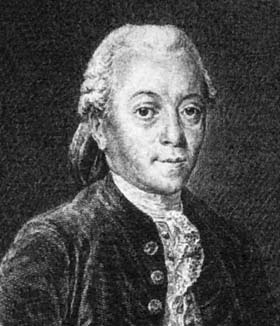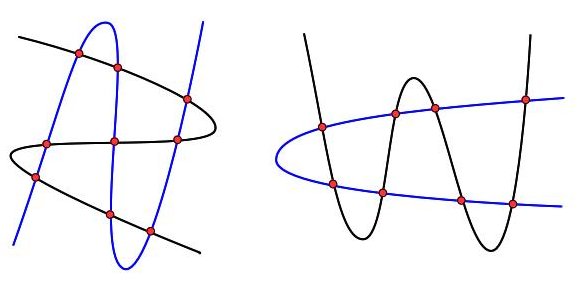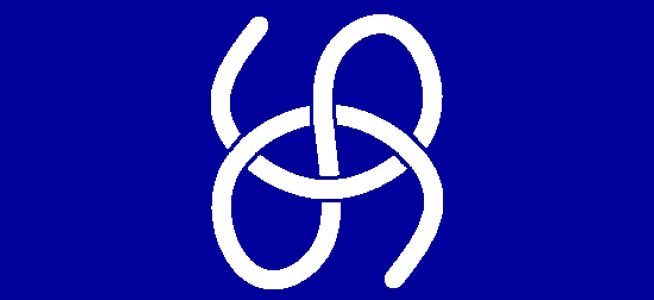Two lines in a plane intersect at one point, a line cuts a circle at two points, a cubic (an S-shaped curve) crosses the x-axis three times and two ellipses, one tall and one squat, intersect in four places.
 In fact, these four statements may or may not be true. For example, two parallel lines do not meet, a line may “miss” a circle, a cubic may have only one real root, or two ellipses may be distant and disjoint:
In fact, these four statements may or may not be true. For example, two parallel lines do not meet, a line may “miss” a circle, a cubic may have only one real root, or two ellipses may be distant and disjoint:
 This is galling to the mathematician, who craves order and neatness. It is more satisfying to make statements that are unconditional, or true in every case. We can rectify the situation if we introduce three new ideas.
This is galling to the mathematician, who craves order and neatness. It is more satisfying to make statements that are unconditional, or true in every case. We can rectify the situation if we introduce three new ideas.
[1] Complex Numbers
First we need to consider complex numbers, not just real numbers. The equation y = x2 determines a parabola and y = – 1 is a straight line. Eliminating y by substitution we get x2 + 1 = 0. Of course, this has no real solutions but it is satisfied by x = √–1= i and x = –√–1 = –i. We can say that the line intersects the parabola at the two imaginary points (i, –1) and (−i, –1). Similarly, a line that “misses” a circle in the real plane actually intersects it at two imaginary points.
[2] Multiple Roots
But what happens if the line is tangent to the circle. We can look at this as the limiting case of two intersections as they move into coincidence. Thus, we regard a tangent contact as a double intersection and count it with multiplicity 2. And there are higher order contacts, which must be counted with the appropriate multiplicity.
[3] Points at Infinity
Finally, we need to add extra “points at infinity” where two parallel lines meet. For each direction we have an additional point at infinity, but we regard the points at each extremity of a line as identical. This is quite difficult to visualise, but it leads to a consistent system called the projective plane. It is similar in a topological sense to a hemisphere in which opposite points on the rim are identified as equal.
Bézout’s Theorem
With these three embellishments, the four statements in the opening sentence are always true. Indeed, with these refinements, we have a much more general result called Bézout’s Theorem. This states that any two curves defined by polynomial equations of degree m and n intersect in precisely mn points. We must realise that some of these intersections may coincide, some may have imaginary or complex coordinates and some may be on the “line at infinity”.

The theorem of the French mathematician Etienne Bézout (1730-1783) has an appealing elegance and simplicity. It is a general statement, with no irksome exceptions or special cases. Under its conditions, algebraic curves are very well behaved. For two algebraic curves, the number of common points equals the product of the degrees of the two curves. For example, two cubic equations must intersect in nine points. What could be simpler?

The result of Bézout was known to Isaac Newton who, in his Principia, wrote that two curves have a number of intersections given by the product of their degrees. The proof was published by Bézout in 1779. The special case where one of the curves is a straight line reduces immediately to the Fundamental Theorem of Algebra: every non-zero, single-variable, degree n polynomial with complex coefficients has, counted with multiplicity, exactly n roots.
Sources
Ash, Avner and Robert Gross, 2012: Elliptic Tales: Curves, Counting and Number Theory. Princeton University Press, ISBN: 978-0-691-15119-9
Silverman, Joseph H and John Tate, 1992: Rational Points on Elliptic Curves. Springer Undergraduate Texts in Mathematics. 284pp.
* * *
 Peter Lynch’s book about walking around the coastal counties of Ireland is now available as an ebook (at a very low price!). For more information and photographs go to http://www.ramblingroundireland.com/
Peter Lynch’s book about walking around the coastal counties of Ireland is now available as an ebook (at a very low price!). For more information and photographs go to http://www.ramblingroundireland.com/
